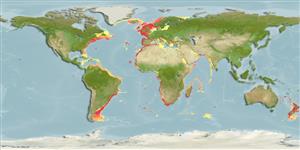Environment: milieu / climate zone / distribuzione batimetrica / distribution range
Ecologia
marino demersale; oceanodromo (Ref. 51243); distribuzione batimetrica 40 - 600 m (Ref. 7251), usually 100 - 200 m (Ref. 36731). Deep-water; 70°N - 55°S, 82°W - 179°E
Eastern Atlantic: Norway to South Africa (Ref. 6633), including the Mediterranean, Canary Islands, Madeira, Cape Verde, and Tristan da Cunha. Western Atlantic: Newfoundland, Canada and Gulf of Maine to North Carolina, USA (Ref. 7251). Recorded from Uruguay to Argentina (Ref. 9050). Western Indian Ocean: St. Paul and Amsterdam islands (Ref. 6633). Southwest Pacific: New Zealand (Ref. 5755, 9072).
Length at first maturity / Size / Peso / Age
Maturità: Lm 77.9 range ? - 90 cm
Max length : 210 cm TL maschio/sesso non determinato; (Ref. 7251); common length : 80.0 cm TL maschio/sesso non determinato; (Ref. 3397); peso massimo pubblicato: 100.0 kg (Ref. 35388); Età massima riportata: 80 anni (Ref. 127279)
Short description
Chiavi di identificazione | Morfologia | Morfometria
Spine dorsali (totale) : 10 - 12; Raggi dorsali molli (totale) : 11 - 13; Spine anali: 3; Raggi anali molli: 8 - 10. Bluish grey above, paler below with a silvery sheen; fins blackish brown (Ref. 6633). Juveniles have black blotches on head and body (Ref. 6633). Body tall, compressed. Big mouth with big head and a rough bony ridge across upper part of the gill cover (Ref. 35388).
Body shape (shape guide): fusiform / normal.
Adults prefer to inhabit caves and shipwrecks (Ref. 27121). Juveniles congregate below floating objects (Ref. 27121). Usually solitary. Feed on large crustaceans, cephalopods and benthic fishes (Ref. 27121). Spawn in the summer (Ref. 35388). Are primary gonochorists (Ref. 58421). Marketed fresh or frozen; eaten steamed, fried, broiled, boiled, microwaved and baked (Ref. 9988). Minimum depth reported from Ref. 6633.
Primary gonochorists (Ref. 58421).
Wheeler, A., 1992. A list of the common and scientific names of fishes of the British Isles. J. Fish Biol. 41(suppl.A):1-37. (Ref. 5204)
IUCN Red List Status (Ref. 130435: Version 2025-1)
Threat to humans
Harmless
Human uses
Pesca: scarso interesse commerciale; Pesce da pesca sportiva: si
Strumenti
Special reports
Download XML
Fonti Internet
Estimates based on models
Preferred temperature (Fonte Biblio.
123201): 5.2 - 19, mean 9.4 °C (based on 672 cells).
Phylogenetic diversity index (Fonte Biblio.
82804): PD
50 = 1.0000 [Uniqueness, from 0.5 = low to 2.0 = high].
Bayesian length-weight: a=0.01318 (0.00965 - 0.01801), b=3.00 (2.91 - 3.09), in cm total length, based on LWR estimates for this species (Ref.
93245).
Trophic level (Fonte Biblio.
69278): 4.1 ±0.64 se; based on food items.
Resilienza (Fonte Biblio.
120179): Basso, tempo minimo di raddoppiamento della popolazione 4.5 - 14 anni (K=0.05-0.08; tmax=76; tm=9-10 yrs estimated from VBGF; Fec=3 million).
Fishing Vulnerability (Ref.
59153): Very high vulnerability (78 of 100).
🛈
Climate Vulnerability (Ref.
125649): Moderate to high vulnerability (50 of 100).
🛈
Nutrients (Ref.
124155): Calcium = 9.7 [6.1, 21.1] mg/100g; Iron = 0.354 [0.174, 0.670] mg/100g; Protein = 19.6 [19.0, 20.3] %; Omega3 = 0.427 [0.332, 0.549] g/100g; Selenium = 25 [11, 55] μg/100g; VitaminA = 7.95 [1.81, 35.92] μg/100g; Zinc = 0.253 [0.178, 0.380] mg/100g (wet weight); based on
nutrient studies.
